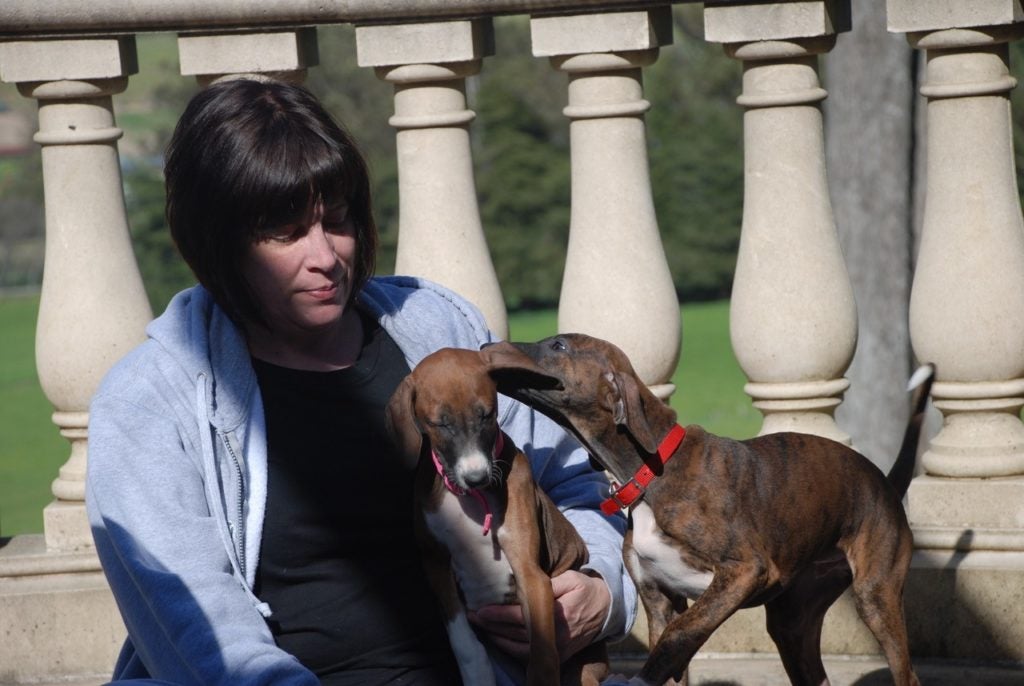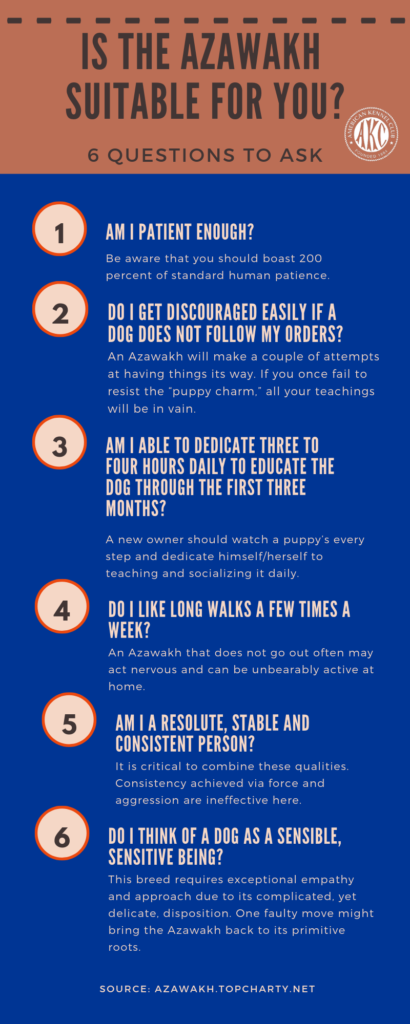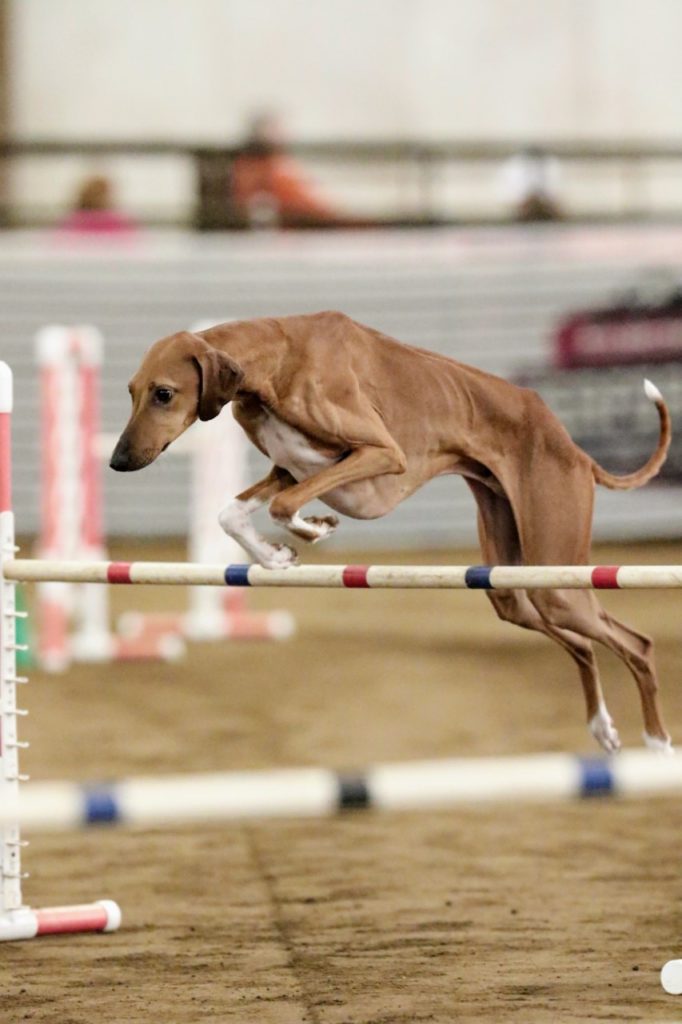
There’s a newly recognized breed coming to American Kennel Club all-breed show rings this year. It has both a tongue-twister name and a unique physique.
Many confuse this breed for a Greyhound or a Whippet, but three owners set the record straight.
Meet the Azawakh
Meet the Azawakh (pronounced AH-ZA-WAHK), a tall, slender Hound originating in West Africa that is lean, nimble, athletic, and renowned for its guarding instinct.
Also known for its gentle, affectionate, and playful demeanor, it will vie in the Hound Group.
The Azawakh was introduced in the U.S. in the mid-1980s, with the first American litter whelped in 1987. All were red or fawn with white markings. Breed growth reached the point where this African native was introduced into AKC’s Miscellaneous Class in 2011.
The parent club, the American Azawakh Association, lists approximately 100 members. Club secretary Deb Kidwell, of Sweetwater, Tennessee, estimates there are between 400-500 Azawakhs nationwide, with Tennessee and the Southeast being the hotbed with approximately 30.
Some are importing dogs from Europe, according to Kidwell, which challenges the club to get an accurate handle on the background. “And with AKC recognizing our breed for full-fledged, all-breed competition, interest has taken off to the point where it’s a bit scary.”
What Questions Do Azawakh Owners Get Most?

“Is that a rescue Greyhound or a Whippet?” she says, without hesitation. “That’s chiefly because of its trim physique and size.” It ranges from 23½ to 29 inches tall and weighs between 35-55 pounds. The AAA recognizes all colors found in its countries of origin – sand to dark red, brindle, white, black gray, blue grizzle, parti-colored and brown.
“Usually I will answer it’s called an Azawakh, a type of African greyhound. That usually satisfies them. And there are always those who say ‘Your dog must have been sick because it’s so skinny.’ I try to be patient at that point. I really do.”

Other Azawakh owners, Lisa Pinto, of Sebastopol, California, and Kayley Page, of North Bend, Washington, receive the “too skinny” responses, as well.
Page, a trainer, adds, “This is a gorgeous, loyal breed with strong guarding tendencies. I love seeing new people in the breed, but you definitely need to do your research before bringing one home. It’s a breed that will bond to you like few others, but it requires lifelong, intense, positive socialization and confidence building.”
How Much Exercise Do They Need?
The Azawakh needs its psychological and physical stimuli, too. “My boy, Anubi, is anomalous,” explains Page. “If I don’t work him mentally at least once a day he gets into trouble around the house. Running him will only slightly mitigate this. Most Azawakhs are like other sighthounds, a solid run every day and they’re happy.”
Anubi accompanies Page to work daily. She has walked him through crowded downtown Seattle without any problems, but cautions, “I have exposed my dogs to every new situation I can think of beforehand so they will be comfortable in those environments. But keep in mind, this is a guarding breed, so if you are new to it, you need to socialize it thoroughly before putting it in crowded, challenging situations.”
Pinto advises, “The Azawakh is not for a first-time dog owner. There are just too many challenges a newbie might have difficulty coping with.”
Kidwell, formerly a Pharaoh Hound owner, was smitten with the Azawakh after reading about it in Dog World magazine in 1988. “I immediately called the editorial department to get contact info for the author of the article,” she recalls. “I was put in touch with the breeder in California and within a month I had my first Azawakh.”
What Surprises Are There With This “New” Breed?
“I thought she was a fragile rose and I quickly discovered she had a backbone of steel. But the bond with her grew to be more intense than any dog I had owned. She would just gaze at me with those big liquid brown eyes and I would melt. A young man I had as a roommate for a while said he wished women would look at him that way,” she laughs.
Before purchasing her first Azawakh, Anubi, more than a year ago from a breeder in France, Page spent three years researching the breed. “Not only did their beautiful aesthetic format immediately attract me but the loyalty and pack-drive the breed exhibits makes it more reliable for off-leash settings, which was everything I wanted in a sighthound.
“I hold nothing back when researching a breed. This meant, there would most likely not be any big surprises.” Well, surprise, she didn’t dig deep enough. “They are big diggers, which isn’t information you read in most breed articles,” Page adds.

Surprises tend to be more in regard to a specific dog rather than the breed generally, she notes. For instance, Anubi seldom barks. He will guard Page or the house when “suspicious circumstances” arise and then sound off. If there is a regular visitor at the door, he leaves the barking to the other household dogs (Saluki and Italian Greyhound/Chihuahua cross) yet remains alert in case action is required. “He’s adept at recognizing what is suspicious and what is commonplace,” Page explains.
Breed-Specific Challenges
From a trainer’s perspective, there are a few breed-specific challenges, she says. “Long sits and downs are more challenging. The sit because sighthounds aren’t built to hold one forever and the down because a cold floor – carpet or mat help – isn’t this dog’s best friend. Conversely, Anubi can hold a stand-stay for minutes even with high-pitched activity nearby.
The breed, adds Kidwell, can be either a family or one-person companion. “Mine have gone both ways,” she adds.
Page says, “There’s levels of trust. I’m very much Anubi’s human. That’s where the strongest bond lies and that bond is like nothing else. In fact, I’ve had people comment on it regularly at dog shows. The next layer is my husband. He loves him; he trusts him. And he’ll do everything he would for me for my husband. However, he won’t respond as quickly or as eagerly. The last layer is trusted individuals, which chiefly includes my family, my husband’s co-workers and other trainers at my work.”
Genetically, the breed is known to have seizures, spondylosis and several immune-mediated diseases, including hypothyroidism.”
If you’re looking for a dog that ages well, the Azawakh’s life expectancy ranges from 12-16 years.
A natural hunter in its homeland, the Azawakh is kept primarily as a companion and family pet in the U.S. In addition to joining its Hound mates in conformation in 2019, it is a good candidate for barn hunt, lure coursing, agility, rally and trick competitions.
Interested in an Azawakh? Check them out here.

